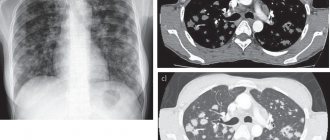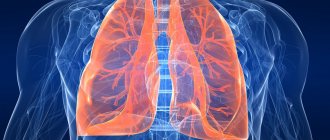The nature and severity of early symptoms of lung cancer in men and women depend on the type, location and stage of the disease. Such tumors are rarely detected in the early stages of development, so representatives of risk groups (smokers, close relatives of cancer patients) need to pay special attention to even mildly expressed symptoms. For the most effective treatment, you should consult a doctor if any alarming changes in your health occur.
Classification
The types of lung tumors are classified according to the location of the primary focus.
Central cancer is localized in the proximal (central) parts of the bronchial tree. The first signs of lung cancer (symptoms), which should alert you, in this case are clearly expressed:
- dry, prolonged cough that cannot be treated.
- hemoptysis begins with the addition of sputum.
- blockage of the bronchial lumen by tumor masses leads to shortness of breath even at rest. In some cases, the temperature may rise.
Photo 1 - Central cancer of the right lower lobe bronchus (1) with obstruction and metastases (2) to the bifurcation lymph nodes
Peripheral cancer gradually forms in the lateral parts of the lungs, slowly germinating and not detecting itself. This lung tumor may not produce symptoms for a long time; they appear with significant local spread, involvement of neighboring organs and structures, and invasion of the bronchi. Diagnosis of lung cancer of this type of localization is most often possible during a preventive examination (x-ray or computed tomography).
Photo 2 - Peripheral cancer (1) of the upper lobe of the right lung
1st symptom – persistent cough
The first sign is a constant cough . Pay attention to how you cough. If the cough goes away after one or two weeks , it means it was the result of a respiratory infection or cold. However, if the symptom does not disappear even after two weeks, it may indicate the development of lung cancer. A cough with mucus is a mandatory reason to see a doctor and undergo appropriate examinations of the lungs and chest - for example, an x-ray. A hoarse or bloody cough, as well as the discharge of a large amount of mucus, are very alarming signs and you should consult a doctor immediately. In such cases, we advise you to undergo examination by Israeli doctors.
Surgical method for treating lung cancer
- the main radical method for stages 1-3 of the disease. Operations performed for this disease are classified:
- by volume of resection (lobectomy (removal of a lobe of the lung), bilobectomy (removal of two lobes of the lung), pneumonectomy (removal of the entire lung)),
Photo 3 - Lobectomy
Photo 4 - Pneumonectomy
- by volume of removal of lymph nodes of the thoracic cavity (standard, expanded, super-expanded),
- by the presence of resection of adjacent organs and structures (combined operations are performed when the tumor grows into the pericardium, trachea, superior vena cava, esophagus, aorta, atrium, chest wall, spine). In addition to surgical treatment, it is possible to use an integrated approach, including radiation and chemotherapy.
When treating locally advanced malignant tumors with transition to the main bronchus and pulmonary artery, in cases where previously the only option for surgical treatment was pneumonectomy, it is now possible to perform organ-preserving operations. In this case, the affected area of the main bronchus is excised, followed by restoration of continuity (bronchoplastic and angioplastic lobectomies)
Photo 5 - Scheme of upper bronchoplastic lobectomy
Cancer of the pleura
Treatment of patients with tumor pleurisy begins with thoracentesis - evacuation of fluid from the pleural cavity, which immediately leads to improved well-being, reduced shortness of breath, pain and improved quality of life of the patient. Examination of the removed fluid, carried out immediately after thoracentesis, makes it possible to more accurately determine the cause of tumor pleurisy. A whole arsenal of modern research methods available to patients at the clinic (x-ray examination, computed tomography of the chest organs, ultrasound, etc.) helps to clarify the extent of the prevalence of not only pleurisy, but also the specific changes that caused this condition.
Some time after the puncture, effusion may again accumulate in the pleural cavity. If the fluid needs to be drained again less than a month after thoracentesis, the doctor may install an intrapleural port system - a small titanium container with a silicone membrane that is placed under the skin and connected by a catheter to the pleural cavity. In the future, in order to remove the pleural effusion, you just need to feel the membrane of the port system under the skin and insert a special needle into it.
Chemotherapy drugs can also be administered through the intrapleural port system. Intrapleural chemotherapy helps reduce effusion formation. It is especially effective in patients with mesothelioma , and breast cancer .
If necessary, it is possible to conduct video thoracoscopy, which allows you to examine the pleural cavity through a puncture in the chest wall using a special instrument - a thoracoscope, to perform a targeted biopsy of a suspicious area of tissue, followed by a morphological study, which in most cases makes it possible to establish an accurate diagnosis.
Systemic chemotherapy not only affects the cancer itself, but also, with good sensitivity to chemotherapy, can lead to the elimination of pleurisy in most patients.
Book a consultation 24 hours a day
+7+7+78
Radiation therapy for lung cancer
Today, such modern methods of radiotherapy as IMRT (radiation therapy with the possibility of changing the radiation dose), 3D conformal radiation therapy (three-dimensional computer planning of selective irradiation) and stereotactic (precisely focused) radiation therapy are being actively implemented. In addition to oncologists, medical physicists, radiologists, dosimetrist physicists and other specialists participate in these manipulations.
Method shown:
- patients with a resectable lung tumor for whom surgical treatment cannot be performed due to contraindications from the cardiovascular system or for other reasons;
- as an alternative to surgery;
- to reduce the risk of relapse in case of damage to the mediastinal lymph nodes, a positive resection margin according to histological examination.
Where can I buy Israeli medicines?
- In Israel - after examination at the oncology center. During the consultation, the oncologist will prescribe medications for you, which can be purchased at an Israeli pharmacy.
- In any locality in the world where the patient lives. The telemedicine program allows patients of the Ichilov Cancer Center to undergo examination by Israeli specialists without leaving home. After diagnosis, the patient will be able to order prescribed medications at home.
Find out if the treatment is prescribed correctly
Chemotherapy
Planning the course of treatment for non-small cell lung cancer includes the use of pharmacological agents. It is used for prevention purposes: adjuvant (auxiliary), postoperative chemotherapy for stages 2-3 of the disease and in the therapeutic course.
Depending on the histological type of tumor, stage of the disease and expected sensitivity to effects, various regimens for the use of chemotherapy have been developed.
Targeted therapy (eng. target - target, goal)
A separate type of pharmacological treatment, which consists in prescribing inhibitor drugs that act only on tumor cells in which various disorders have been identified, delaying or even blocking further growth.
- Tyrosine kinase inhibitors (gefitinib, erlotinib, afatinib) are used in the treatment of patients whose tumor tissue has mutations in the EGFR gene.
- If the EGFR mutation status is negative, use ALK inhibitors (crizotinib, alectinib).
There are targeted drugs, the prescription of which does not require the identification of any abnormalities in tumor cells. These include bevacizumab (VEGF inhibitor), nivolumab and pembrolizumab (anti-PDL1 antibodies).
Pleurodesis
If chemotherapy is not possible, it is possible to perform pleurodesis, as a result of which the layers of the pleura are fused together by introducing various chemicals with a local antitumor effect.
Intrapleural therapy for cancer can be supplemented with immunotherapy with LAK cells, recombinant interleukin-2, or a combination thereof.
The choice in favor of one or another option of immunotherapy or the sequence of immunotherapeutic effects is made by the oncologist based on the results of the examination of the patient, taking into account the rate of fluid accumulation, general condition, sensitivity to chemotherapy, previous treatment, etc.). Thoracentesis is performed by experienced specialists using a special Pleurocan device (USA) and only under ultrasound navigation, which ensures safety, speed and accuracy of the intervention.
Life forecast
The prognosis of lung cancer in NSCLC includes symptoms, tumor size (> 3 cm), non-squamous histology, extent of spread (stage), lymph node metastasis and vascular invasion. Inoperability of the disease, severe symptoms and weight loss of more than 10% give lower results. Prognostic factors for small cell lung cancer include condition status, sex, stage of disease, and involvement of the central nervous system or liver at the time of diagnosis.
For non-small cell lung cancer, the prognosis for life with complete surgical resection of stage IA (early stage of the disease) is 70% five-year survival.
2nd symptom – shortness of breath
This symptom may also indicate lung cancer. Difficulty breathing in this case can have two reasons: either fluid has accumulated in the chest as a result of the development of a cancerous tumor, or a narrowing or obstruction of the airways has occurred. Thus, if, as a result of normal, everyday activities, you suddenly begin to feel short of breath - and everyday activities include going to the store, climbing stairs, and similar simple actions - it is strongly recommended to consult a specialist.
Euroonco doctors know how to help
We are confident that we can always help, so we undertake the treatment of patients with lung cancer at any stage:
- Euroonko performs complex surgical interventions.
- Our doctors use original drugs of the latest generation with proven effectiveness.
- We have a palliative care department that is unique for Russia.
- For patients in whom further treatment is not appropriate, we provide hospice services with an unlimited stay.
- We know how to increase the effectiveness of chemotherapy and what to do if the prescribed treatment does not help.
- Our doctors know how to deal with pleurisy and other complications of lung cancer.
- We use effective supportive therapy, which helps to cope with side effects and tolerate the main treatment well.
Characteristics of the small cell type
Small cell lung carcinoma is an extremely unfavorable tumor, often developing against the background of tobacco product abuse. It occurs in 16% of cases, and every year it affects more and more women. For several decades, before the development of effective treatment methods, the average life expectancy after diagnosis was about 12 weeks.
The main problem of such carcinoma is that it grows very quickly, and the formation of metastases requires a minimum of time. This type of cancer without metastases is diagnosed only in 5% of cases. This statistics explains the futility of local treatment (meaning surgery and radiotherapy). Due to the rapid spread of cancer cells, the best method of control is the use of oncology vaccines.








